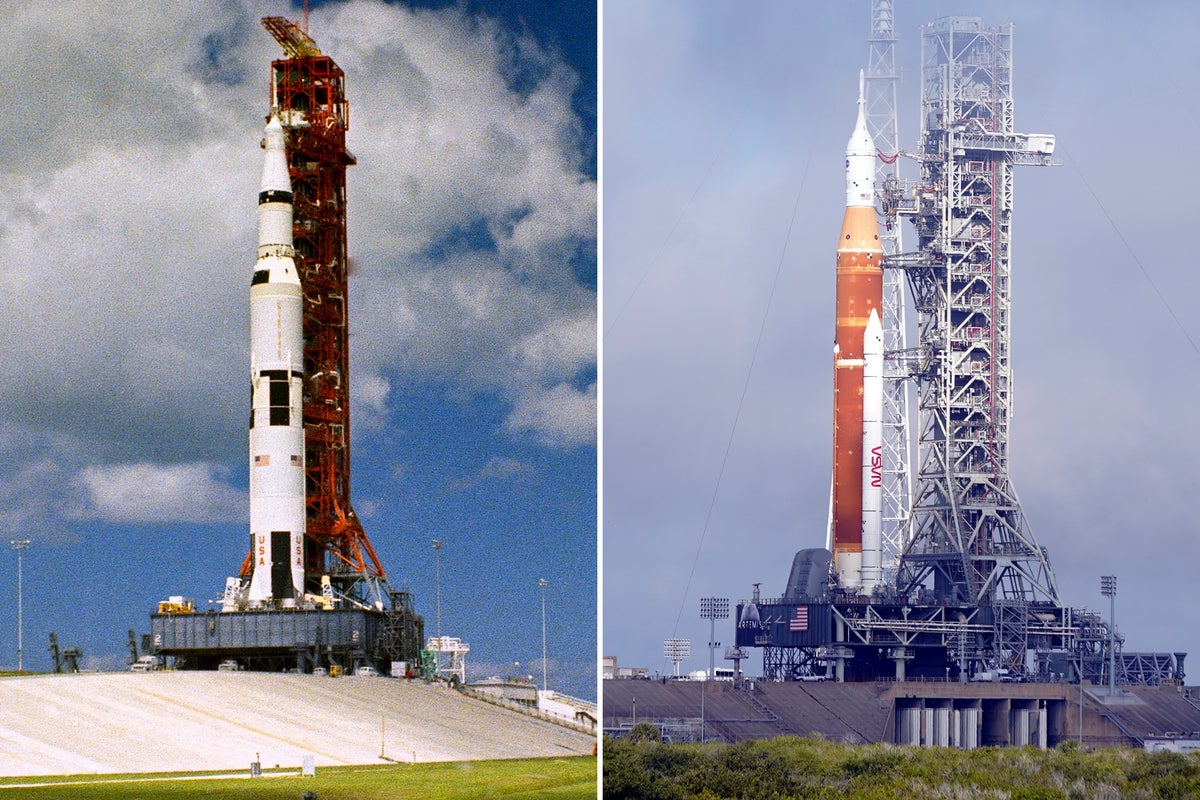
NASA is kicking off its new moon program with a test flight of a brand-new rocket and capsule.
Liftoff was slated for early Wednesday morning from Kennedy Space Center in Florida. The test flight aims to send an empty crew capsule into a far-flung lunar orbit, 50 years after NASA's famed Apollo moonshots.
The project is years late and billions over budget. The price tag for the test flight: more than $4 billion.
A rundown of the new rocket and capsule, part of NASA’s Artemis program, named after Apollo’s mythological twin sister:
ROCKET POWER
At 322 feet (98 meters), the new rocket is shorter and slimmer than the Saturn V rockets that hurled 24 Apollo astronauts to the moon a half-century ago. But it’s mightier, packing 8.8 million pounds (4 million kilograms) of thrust. It's called the Space Launch System rocket, SLS for short, although a less clunky name is under discussion. Unlike the streamlined Saturn V, the new rocket has a pair of side boosters refashioned from NASA’s space shuttles. The boosters peel away after two minutes, just like the shuttle boosters. The core stage keeps firing before crashing into the Pacific. Less than two hours after liftoff, an upper stage sends the capsule, Orion, racing toward the moon.
MOONSHIP
NASA's high-tech, automated Orion capsule is named after the constellation, among the night sky’s brightest. At 11 feet (3 meters) tall, it's roomier than Apollo's capsule, seating four astronauts instead of three. For the test flight, a full-size dummy in an orange flight suit occupies the commander’s seat, rigged with vibration and acceleration sensors. Two other mannequins made of material simulating human tissue — heads and female torsos, but no limbs — measure cosmic radiation, one of the biggest risks of spaceflight. Unlike the rocket, Orion has launched before, making two laps around Earth in 2014. For the test flight, the European Space Agency's service module was attached for propulsion and solar power via four wings.
FLIGHT PLAN
Orion’s flight is set to last 25 days from its Florida liftoff to Pacific splashdown, about the same as astronaut trips. It takes nearly a week to reach the moon, 240,000 miles (386,000 kilometers) away. After whipping closely around the moon, the capsule enters a distant orbit with a far point of 38,000 miles (61,000 kilometers). That puts Orion 280,000 miles (450,000 kilometers) from Earth, farther than Apollo. The big test comes at mission’s end, as Orion hits the atmosphere at 25,000 mph (40,000 kph) on its way to a splashdown in the Pacific. The heat shield uses the same material as the Apollo capsules to withstand reentry temperatures of 5,000 degrees Fahrenheit (2,750 degrees Celsius). But the advanced design anticipates the faster, hotter returns by future Mars crews.
HITCHHIKERS
Besides three test dummies, the test flight includes a slew of stowaways for deep space research. Ten shoebox-size satellites pop off once Orion is hurtling toward the moon. NASA expects some to fail, given the low-cost, high-risk nature of these mini satellites. In a back-to-the-future salute, Orion carries a few slivers of moon rocks collected by Apollo 11's Neil Armstrong and Buzz Aldrin in 1969, and a bolt from one of their rocket engines, salvaged from the sea a decade ago.
APOLLO VS. ARTEMIS
More than 50 years later, Apollo still stands as NASA’s greatest achievement. Using 1960s technology, NASA took just eight years to go from launching its first astronaut, Alan Shepard, and landing Armstrong and Aldrin on the moon. By contrast, Artemis already has dragged on for more than a decade, despite building on the short-lived moon exploration program Constellation. Twelve Apollo astronauts walked on the moon from 1969 through 1972, staying no longer than three days at a time. For Artemis, NASA will draw from a diverse astronaut pool and is extending the time crews spend on the moon to at least a week. The goal is to create a long-term lunar presence that will grease the skids for sending people to Mars.
WHAT'S NEXT
There's a lot more to be done before astronauts step on the moon again. A second test flight will send four astronauts around the moon and back, perhaps as early as 2024. A year or so later, NASA aims to send another four up, with two of them touching down at the lunar south pole. Orion doesn’t come with its own lunar lander like the Apollo spacecraft did, so NASA has hired Elon Musk's SpaceX to provide its Starship spacecraft for the first Artemis moon landing. Two other private companies are developing moonwalking suits. The sci-fi-looking Starship would link up with Orion at the moon and take a pair of astronauts to the surface and back to the capsule for the ride home. So far, Starship has only soared six miles (10 kilometers).







